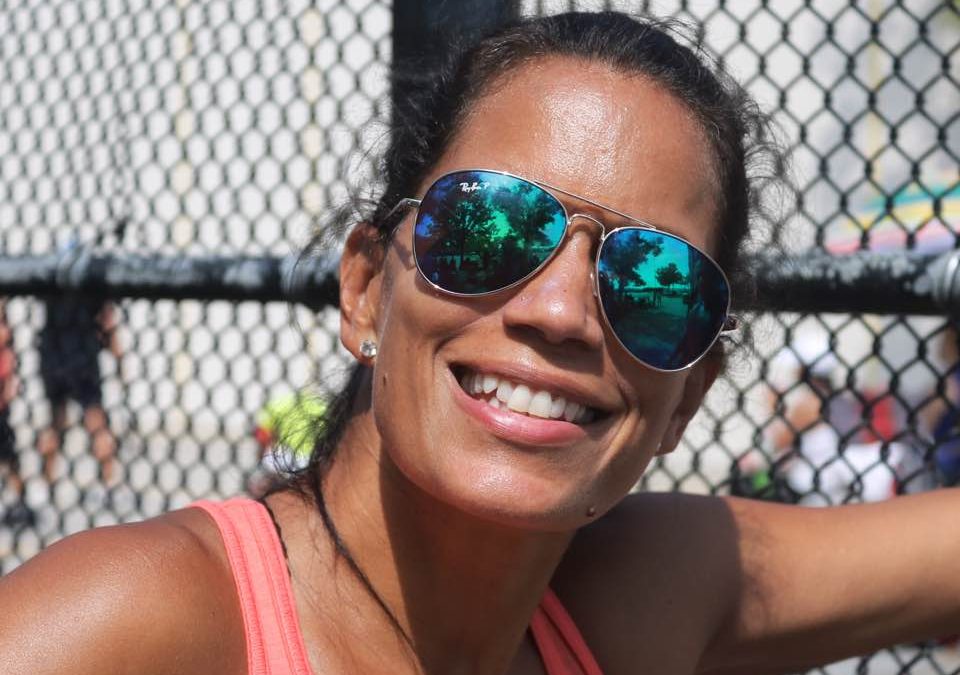
by Mike Melendez | Apr 20, 2018 | Weekly Player Profile
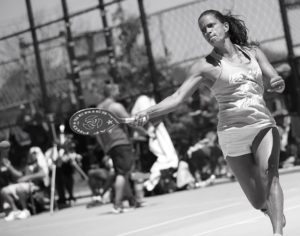
Liz Colon Paddleball Profile No-38 By Mike Melendez & Dave Siegel
In just two short years, Liz Colon has made an amazing impact on the sport of paddleball. Not only is she one of the top women players, but more importantly, she has shown a true passion for promoting the game and has big hope for its future growth. Her most visible impact is her live streaming of one-wall games on her Facebook “Liz Live” page. But her biggest contribution is as a loving, caring, helping friend to everyone she touches in the paddleball community, and the paddleball world loves Liz! Her close friend, Maritza Alicea tells us, “She is a genuine loving person with an easy smile who will help anyone who really needs it…… as long as you ask her by text, she hates talking on the phone!” So, you heard it here, text her, do not call!
Liz was born and raised in the Fordham Road/Kingsbridge section of the Bronx. She is the youngest of four children, with two brothers and a sister. As with many paddleball players, she started in handball, playing at Aqueduct Park under the tutelage of her long time mentor, Master Web. Through her hard work and passion for handball, Liz developed a strong game and became one of the best women players at Aqueduct. As we now know, Liz is driven to be the best she can be at whatever she puts her mind to. She knew that in order to move to the next level, she needed to play with stiffer competition. So she packed her bag and went out looking for better games. Her first stop was St. James Park, not far from Aqueduct, and later on to West 4th Street. Liz became an excellent player and though she didn’t compete in handball tournaments, she dished out plenty of #PowPows!
Many paddleball players transitioned from handball, but in Liz’s case, at the age of thirty, she switched from handball to racquetball. Then one day at Van Cortlandt Park, paddleball legend Robert Sostre introduced her to Big Blue paddleball, which Liz took an immediate liking to. But Big Blue games were hard to find, so she tried small-ball for a year, playing in a regular indoor game with a great group of ladies. Then the racquetball boom came along and her small-ball paddleball ceased as she joined the racquetball wave.
Liz’s paddleball story really started two years ago when she started playing it consistently at Zerega Indoor and Marathon Park and it didn’t take long for her to become one of the top women players in the game. Undoubtedly, her experience in handball and racquetball, as well as her dedication and natural athletic ability, were all important factors in her rapid ascension. She is a dynamic right-handed competitor with one of the most powerful forehands in the ladies division. Liz is like a lioness stalking her prey, patiently waiting for the perfect opportunity to attack and put her opponent on the defense. When she gets a set-up, her eyes look like they’re about to pop out of their sockets and she goes into BEAST mode on the poor ball! Her favorite shot? But of course, “Drive shot to the body. I like hitting the ball hard, it feels good! I love the sound of the ball slamming against the wall.” And like every successful athlete with the drive to rise to the top, she works hard, playing 2 to 3 times a week to improve her game. She says it’s a great workout and a great way to let off steam! How does she describe her game? “A work in progress. LOL. I’m still learning. Every time I play, I learn something new and I try to focus on improving that one thing!” Ladies of paddleball, are you listening?
Liz is not only an excellent player and a helpful, popular friend to the paddleball community, but also a very thoughtful person who has many insights about the game and how it can flourish. What does she think the sport needs for it to grow? “I have so much hope for this game and I only wish to see it continue to grow. We need more people who give of themselves selflessly to make great events and promote the game. Charlene Gilio is a great example, constantly organizing games throughout the year and coming up with fresh new ideas for events that keep people interested and wanting to come back. People like Kathy Guinan, Mike Waters and Cindy Figueroa, who always offer themselves in any capacity just for the love of the game, GENUINELY! It’s heartwarming. And of course people such as you, Mike, who dedicate their time to introducing and teaching the sport to our youth and keeping up with it.”
What advice does Liz have for her peers? “Appreciate the time that others dedicate to putting tournaments together. RESPECT the time they are taking away from their lives/families to put on these events, while looking at the bigger picture. Also players should think about not just what the event can do for you, but what your contribution and participation can do for the event. I know lots of players choose not to participate because they feel they have no chance at winning. Imagine if everyone thought that way, we’d never have tournaments! I enjoy playing and participating in whichever events I can, just to add to the pot! I’d like to see some of the Pro/A players go out of their comfort zone and pick a player whose skill level is a little less than theirs for an open tournament, just to make things interesting and give more people the opportunity to win.
Is there something she would like to change about the sport? “I’d like to make it more difficult for people who behave poorly during the events. Like with any other sport, there are immediate consequences (technical fouls accompanied by fines, suspensions, etc.), make these punishments on-the-spot and stay consistent with it so players are not so quick to argue with a ref, lines-person, spectator or each other. That type of behavior is not tolerated anywhere else and should not be tolerated here either.” This writer agrees with Liz 100% and this is something the PFA has organized with the help of other tournament directors and put in place during the past year.
Liz says the sport of paddleball is very dynamic, no two players play the same way. She loves watching and playing against all the different styles of play. But when we asked her who is her favorite player, we got more than we asked for. “OMG there’s so many. Of course Robert Sostre and his ability to pick and place almost any shot he wants. Maira Rosario-Ramos as well, she’s aggressive and can kill the ball from anywhere on the court and has excellent court awareness. My mixed partner Dave Blatt and his aggressiveness and quick hands. Carlos Espinal and his shot arsenal is ridiculous, spiking, powering the ball from anywhere on the court, it’s just insane. But my new favorite is newcomer Suly Ruiz. She’s very smart with her shot placement and has carried over her handball skills right to the paddleball side. It’s amazing how quickly she’s advanced. I’ve learned so much from each of these players and so many more.” You would think with all these paddleball greats that she marvels, one of them would be her sports hero, but no, it’s Michael Jordan. “Whenever he played I felt like I was witnessing greatness. He’s a true example of a “GIFTED” person.”
If you would like Liz to expound on these insights, or for her to help out in any way, just ask her, but don’t call her, TEXT! SHE HATES TALKING ON THE PHONE!
#LizGotNext!
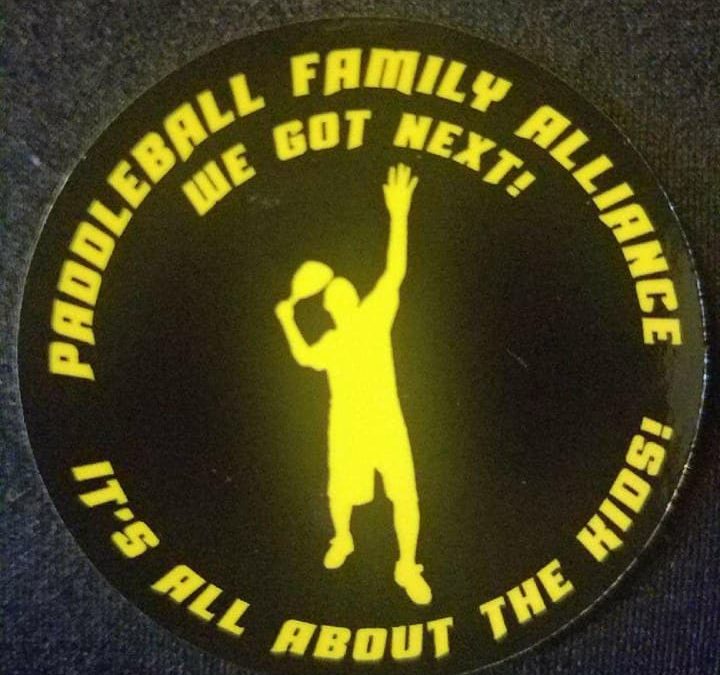
by Mike Melendez | Apr 15, 2018 | Informational, News Release
Click here to access PFA 2018 Tournament Results Database
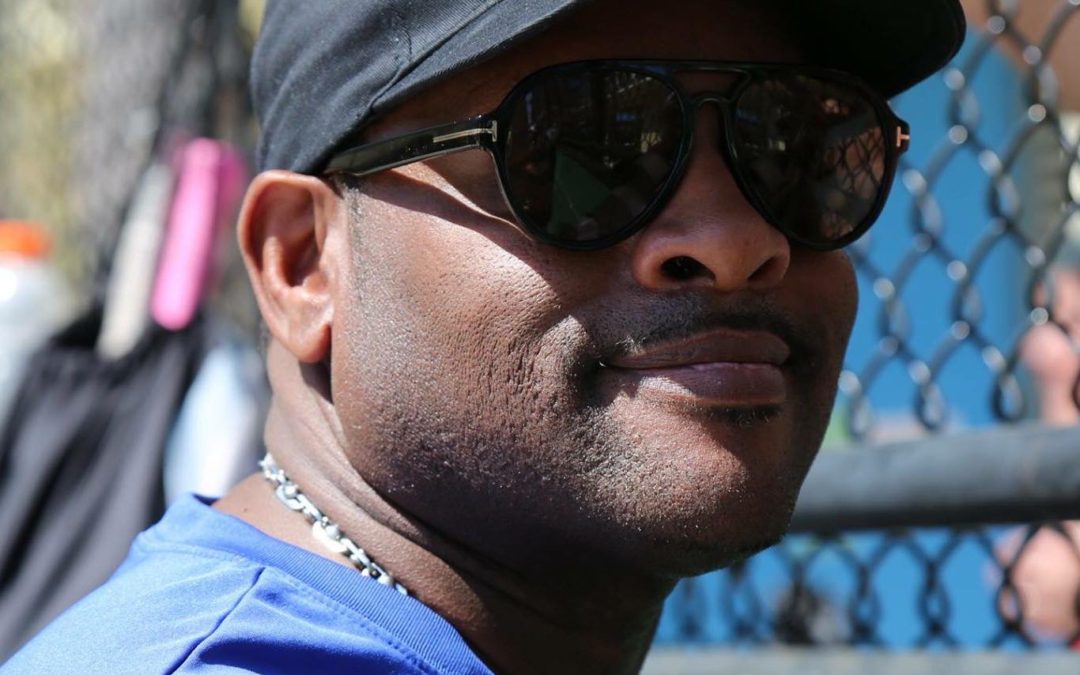
by Mike Melendez | Apr 6, 2018 | Weekly Player Profile
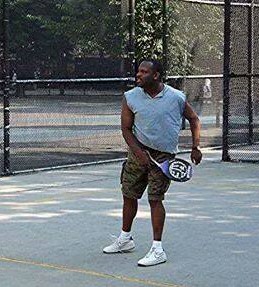
Jazz Jimmy Paddleball Profile No 37 by Mike Melendez
He has a low-key quiet demeanor, but don’t let that fool you! He is a music promoter, a paddleball promoter, loves to travel and can be found shopping in many of the high-end clothing stores around the city. He loves to eat out, as reflected by the tons of photos on his Facebook page of gourmet meals at restaurants around the city. I think the guy is working on his Gourmet Chef degree! But, like many of us, John Cherry, Jazz Jimmy as he likes to be called, feels most comfortable on the paddleball courts.
Jimmy’s paddleball story started thirty-five years ago at Fort Greene Park in Brooklyn NY, where he was born and raised. The famous Carmine Street paddleball courts in the Village is where Jimmy fell in love with the sport back in the 80s. Jimmy recalls, “I used to go down to Carmine’s and watch the players from the gate and it was just the excitement that got me interested in the sport.” At Fort Greene there weren’t any top players, just regular locals playing, hanging out and having a good time. One winter Jimmy decided to take his game to George McFadden’s Paddle Sports indoor courts, looking to upgrade his skill by playing stiffer competition. At this facility he played with the likes of Jimmy Gibson, Godfrey Brown, Pineapple Eddie, Jimmy Hoey and Pete Pilarte. The next summer Jimmy came back to Carmine, this time not to watch from the gate, but to compete with the top players such as the late Clarence Davis, Andr’e Hopkins, Freddy Diaz and many others. Jimmy had arrived to the big league of paddleball!
He has always been a fan of most of the seasoned players, but the one player he looked up to was Robert Chielli. He said, “In my opinion Robert was the best right-side player and that’s why I love playing that side so much.” Jimmy is a very good player with pop in his right and a very good left hand. But the essence of his game is based on placement and smart shot selection. His favorite shot is down the right side and a deadly right to left cross-court. Not surprisingly, these are two of the shots Chielli was known for.
In the late 90s, like most players, he transitioned from paddleball to racquetball. The switch was primarily due to the lighter racquets and the lack of tournaments in paddleball. But, like the majority of players that made this transition, he has returned to the exciting game which he fell in love with back in the days of Carmine. Presently Jimmy plays paddleball twice a week. During the summer season, his home park is Colucci Park in the Bronx, where mainly big ball is played, and in the winter, it’s Zerega Indoor.
On the personal side, he is obviously a food lover and his favorite is West Indian cuisine. When it comes to sports role models, he has no favorite individual but he loves his football Giants. His other sport is basketball, which he also loves to play.
Back to paddleball, Jazz Jimmy is one of the paddleball players today actively promoting our beloved sport and is very well liked by the paddleball community. I asked Jimmy if he feels paddleball has a future. “I think the sport still has room for growth, we just need to promote it more. I think if we can get more organizations involved and pitch a group story about the game and keep getting the youth involved, it would grow.” I asked him how do we get there? “More players must volunteer and go out and work with the younger generation and teach them about this amazing sport.” I hear you Jimmy! He also said that “It would be great if we can continue to work together to support each other and recruit new players.” This writer agrees with you 100%, Jimmy! His advice to his paddleball peers is, “Continue to play paddle and enjoy what you know best and that’s Having Fun!” About the PFA, he said, “I think the PFA is doing an excellent job promoting the game, it is well organized and lots of information about the sport can be found in its paddleballfamily.com website.” Our sport needs more individuals like Jazz Jimmy!
#JazzJimmyGotNext!
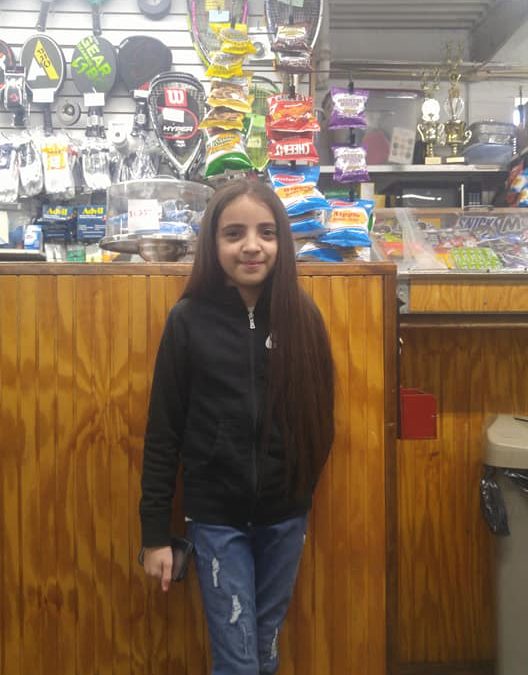
by Mike Melendez | Mar 27, 2018 | PFA Youth PB Profile
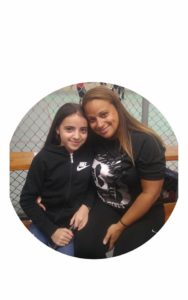
Jazlene Montes Paddleball Youth Profile No2
Something beautiful is happening in the sport of paddleball. The youth seeds are starting to take root on the indoor and outdoor courts. Jazlene Montes, most know her as Jazzy, is one of those paddleball seeds starting to sprout into a beautiful flower that lights up the courts with her easy smile. Yes, kids like Jazzy are turning the paddleball courts into beautiful gardens!
Jazzy is one of the promising members of the PFA Paddleball Youth Clinic program. She is ten years old, a bit shy and has an infectious smile that makes you want to cheer for her. The youngest of four sisters and two brothers, Jazzy started playing paddleball about a year ago on the courts of Castle Hill Park, also known as “The Pit”. This princess has all the tools of a future paddleball queen: She is long, quick on her feet and has good hand-eye coordination. Paddleball is in her DNA. Her mother, Suly Ruiz, is an outstanding handball player, who in just over a year of playing paddleball, has put the sport on notice by winning and placing in a number of open tournaments.
Jazzy originally started playing handball on and off at the age of five. But by watching her mother play paddleball during the past year, she switched to the paddle and has embraced the game and developed a love for it. So much so, that paddleball has become her favorite sport. I asked her, “What do you like best about the game of paddleball?” Her eyes lit up with her beautiful smile, “Playing with friends and having lots of fun, which is one of the reasons I love the PFA paddleball clinic.” She enjoys playing in front of big crowds and having people cheer for her, especially when she rolls the ball out which, of course, is her favorite shot.
Her favorite subject in school is Art. She draws very well and proudly showed me some of her drawings of horses on her phone. She is also an avid animal lover and has a female dog named Lulu, a cat and a bunny, and she rides horses. Because of her love for animals, she wants to be a veterinarian when she grows up. For Jazz, a perfect day is riding horses at Orchard Beach and writing about the day.
She likes to watch the video game “Road Blocks Kids” on YouTube. Her favorite movie is Disney’s “Moana”, the legendary demigod whose goal is to save her people. Jazz loves to watch the “Sponge Bob” TV show with her 18 year old sister. I asked her what super power she would like to possess. “I would love to be able to talk to animals in their own language.” With that infectious smile, she should not have any problem communicating with animals, or human beings!
Jazzy #GotNext!
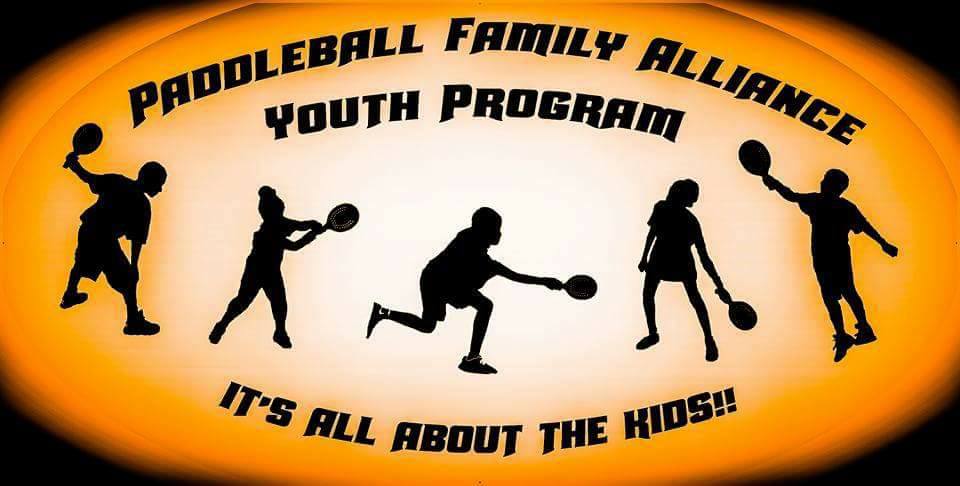
by Eddy Cabrera | Mar 26, 2018 | Legend of the Game, Weekly Player Profile
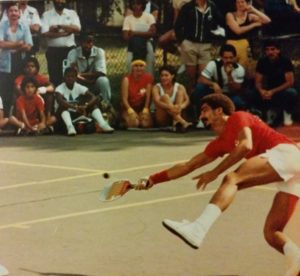
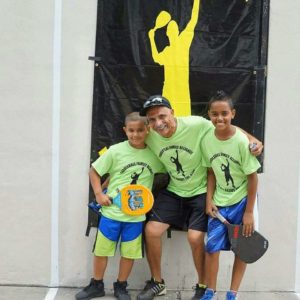
Mike Melendez Paddleball Player Profile No-36 by Dave Siegel
The Paddleball Family Alliance has inducted two greats into its Hall of Fame: Howie Hammer and John Bruschi. Everyone will agree that both are well deserving of this honor, but who should be next? You could make a case for several legends, but there is one player who must get major consideration because he actually qualifies twice! Mike I and Mike II. The paddleball world is well aware of Mike II, who is a present day top doubles player and the most significant contributor to the game since Mr. Paddleball, Howie Hammer. Without Mike’s tireless work during the past five years, the sport likely would have continued its downward spiral, but instead it is in the midst of a remarkable rebirth. But it occurred to me that some of today’s players may not be totally familiar with Mike I, who played in the golden age of paddleball and is the most dominant singles player ever.
Mike Melendez was born in the Dominican Republic and came to the United States at the age of fourteen, settling in the Bronx. He started out playing handball at Ogden Park and eventually transitioned to paddleball. One day a short time later, on his way to a Yankee game at the Stadium, as he passed the adjacent paddleball courts, Mike noticed a large crowd was gathered. They happened to be watching a paddleball tournament finals match and he stopped by to take a look. For the first time, he observed what paddleball played at a high level was like and loving what he saw, he immediately decided this is where he had to be. So Mike went back to Ogden and doing what he does best, he put in hours and hours of practice time. When he felt he was ready to move up to a higher level, he went back to the Stadium, but much to his chagrin, he was frozen out of the good games by the cliquish players. This fueled his desire to succeed even more and he persisted of course, and in a short time, he made it into the “A” game and eventually took great glee when he beat them all!
Throughout his life, he has had an intense desire for excellence and to strive for success. It is obvious that to him the only way to achieve his goal is through hard work and dedication. He didn’t get to be a great player with only his natural talent. Why singles? He now says that he gravitated to the singles game because he was in control of the court, not relying on a partner, and unlike present day, singles was big-time back then. He also loved (and still does) to practice his game without a partner. His training regimen is legendary, spending long hours perfecting his repertoire of shots. Back in his heyday, he would play or practice five hours a day, every day. Realizing that the angle serve was a great weapon in singles, Mike would place a can of soda in the corner by the short line, aimed for it with serve after serve, and actually hit it often. It also helped that he was a tennis fan and the great singles player Bjorn Borg was his sports idol. Mike Melendez went on to dominate the singles game during paddleball’s golden age, highlighted by winning six of seven Budweiser singles titles from 1980 to 86.
What type of player is Mike Melendez? He was (and is) a very offensive player, relentlessly attacking the ball using great angle shots and jams to put his opponent on the defensive, setting up his deadly put-away kill shots. But he is also a complete player who enjoys playing defensively. His motto is “Play the ball, do not let the ball play you.” Back in the 80s, Mike played paddleball with all his heart and soul, his life centered around the game, feeling that it would become his career. With the half million or so players in the tri-state area, major sponsorship in site, Mike says that he truly believed that paddleball was about to propel to a national game and become the next major sport. But, sadly, this was not to be.
In 1987 Mike took a “brief” 25 year hiatus. He took up a new sport: marathon running. As we all know, distance running requires intense training and Mike was surely not adverse to that. He ran ten marathons, finished them all, achieving a best time of 3:11. He also took up tennis, and became a “pretty good” player (his words). I bet he’s better than pretty good.
How did Mike II come to be? In 2012, he happened to stop by Van Cortlandt Park and watched some paddleball, and as he says, “a fire ignited inside me.” Also, he had become plagued by an ailing knee and had come to realize that covering a large tennis court was not the greatest idea. So Mike decided it was time for his paddleball comeback. Now living in New Jersey he, of course, practiced and practiced by himself near his home and when he felt he was ready, he returned to the game. Now a part of paddleball again, Mike took a step back and didn’t like everything he saw. Most of the players at the courts were playing racquetball, not paddleball. But the worst was that everyone was old! Where were the young adults and the kids? It’s great that older people played paddleball, but Mike knew the game would die out if there was not a big infusion of youth. And then it hit him: Paddleball was a great sport back in the 70s and 80s, but the key to its decline was that we forgot to invest in the youth! Mike was determined that we don’t make that mistake again!
In 2013, with the same dedication and hard work that defined Mike’s youth, he formed the Paddleball Family Alliance and it became a great vehicle to promote the game, attract players back to paddleball and most importantly get the youth to take up the game and stick with it. From the start, he knew that he would need lots of help along the way and turned to his trusted paddleball friends like Hoppy, Mitch, Kathy and Ray S. and they did not let him down. As the rolling snowball grew, many others have volunteered their time to further the cause. Knowing that money would be paramount to getting things done, he set up the PFA as a legitimate non-profit organization, which facilitated the recruitment of business sponsorship as well as individual donations. And indeed there has been strong financial support. Obviously, communication was key. He formed the Facebook group and web-site and used other social media outlets that became important in spreading the word. In order for paddleball people to get to know each other better (as in Paddleball Family), Mike organized get-togethers of players across the tri-state area (PowPows) and fostered the paddleball profile program. He addressed the thorny issue of inappropriate behavior on the court with a new Code of Conduct and made sure the PFA held the players accountable. Knowing there were still gaps and ambiguities in the rules, Mike organized the update of the rulebook and continues to communicate it. Mike always felt tournament competition was one of the keys to growing the game and the PFA has sponsored many successful tournaments. But, unquestionably the cornerstone of the PFA is the youth program: the successful kids clinics, the kids exhibitions at tournaments, and in the pipeline, the introduction of paddleball into the NYC high school system. And don’t forget the PFA slogan: “It’s all about the kids!” Speaking to Mike now about children in paddleball, it’s obvious where his passion is. He just loves teaching and helping kids improve their lives through paddleball. Even if there was no paddleball, Mike would for sure be involved in youth programs and teaching.
What about Mike Melendez, the person? He is a proud family man, with his beautiful wife, Maggie, three grown-up children and three grandchildren. He says he’s retired, for now… What does that mean? In the past, he has played many other sports besides paddleball, tennis and running marathons, including baseball, basketball, bowling and speed skating. But now, it’s pretty much paddleball, which he now plays twice a week. He’s also a celebrity. During the era of his singles dominance, Mike starred in a Budweiser commercial. No, he was not guzzling a brew, he was playing paddleball! Unfortunately, as much as we’d like to see it, Mike says it’s unavailable. But he can tell us all about it and how it almost never came to be.
What does Mike feel is most important for the sport to continue its upward spiral? It’s addressing the most significant factors in paddleball’s downfall after the 1980s. First, people must get involved by volunteering their time in one way or another in mentoring the kids and keeping them interested. Secondly, it’s setting the example of good sportsmanship and to support the efforts to make it part and parcel of the sport. Also we have to accept that the big-ball game has emerged and has overtaken the traditional small-ball. Though Mike loves the speed of small-ball, the big ball is easier to control and the game is more spectator-friendly because the rallies are longer. But at the end of the day, “It’s all about paddleball!”
Mike Melendez has become paddleball’s leader and inspiration. He has this message to everyone involved in the game today: “I want to thank all of my peers that are volunteering their time and energy in promoting our beloved sport of paddleball. Together we can do it. The future of paddleball is looking great!” Mike Melendez, You Got Next!
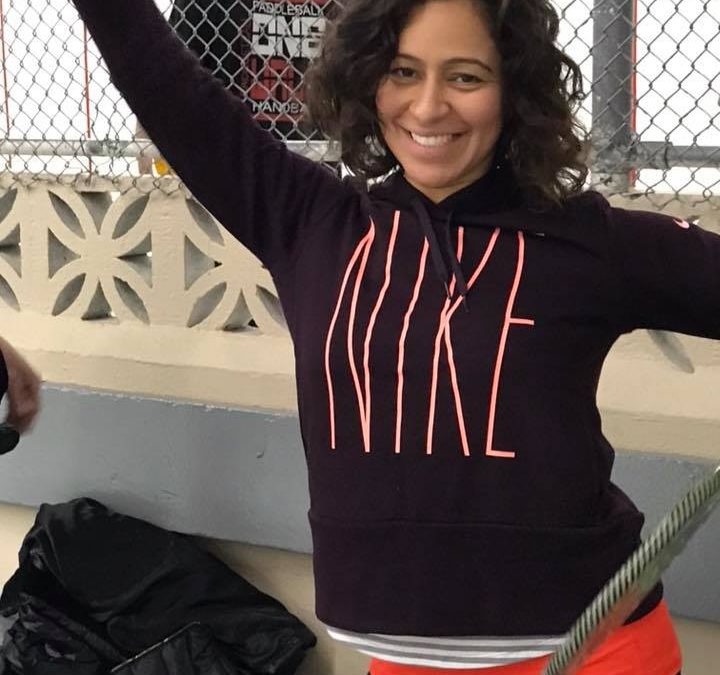
by Mike Melendez | Mar 21, 2018 | Weekly Player Profile
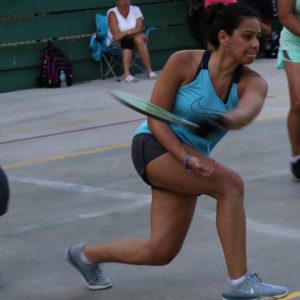
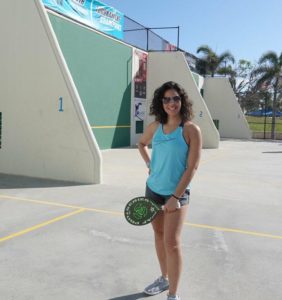
Omaris Journet PFA Paddleball Profile 35 by Kim Ramos
Omaris Journet has a big smile and an easy laugh. But don’t let that fool you! She is a dynamic left-handed competitor, always striving for perfection on the paddleball courts. Amazingly, she has been playing Big Blue for just over a year and is already one of the top female players in the game, never afraid to scrape a knee diving to get her shot. However, for Omaris her success in paddleball is not a surprise. Once she decides to do something, she expects nothing but the best from herself. She is a natural athlete and combined with her dedication, the sport comes easily for her.
On most weekends Omaris, also called Omi by her friends, drives down from Connecticut to play at her summer paddleball home of Orchard Beach or Zerega during the indoor season. Omaris has been playing racquetball for the last 11 years, but like many players over the past year, she has transitioned to the Big Blue game. She enjoys the sport of paddleball as a good cardio workout that’s good for all ages and provides a great sense of community/family.
There isn’t a player she models herself after, preferring to develop her own game. In describing her game, Omaris says she is not sure if she has developed her own style of play yet, but she likes a deep court shot and a chest shot. Her goal is to be consistent whenever she steps on the court. One player she enjoys watching and playing against is Miriam Silva. She says, “I do enjoy watching and playing against Miriam as I think she is a great player and she brings out the best in me.”
We asked Omaris what she thinks is needed to grow the sport and her response was, “I think the sport needs a lot more exposure (nationally). Our youth needs to be recruited to the sport in order for it to grow, and getting younger players sponsored will also help. Having conversations with racquet/paddle brands such as Gearbox and teaming up with them to host tournaments or jump in with the racquetball tourneys throughout the country would also help. Paddleball needs more money. Consider what handball has done to grow the sport: more money = more people = younger players = Bigger Sport! Handball players are great athletes that can help paddleball grow, as they have shown that the transition into paddle for them is pretty easy. But there has to be an incentive and for them; it’s money!”
Omaris has this advice for her fellow players “Do not let this game define you because this is not what you’ll be remembered for. Your legacy will be who you are and what you do off the court.”
Omaris’ athleticism is on display in the many other sports she participates in. She is a very good volleyball player, swimmer, softball player, and snowboarder. She also really enjoys playing table tennis, which gives her the good hands she possesses on the paddleball courts. One of her goals is participating in a triathlon before she reaches the age of 50.
Her interests outside of sports include her love of dogs; her favorite food is a good Vianda con gazpacho and she can play a mean clarinet.
Omaris Journet is quite a well-rounded person and athlete, and one of the up-and-coming stars of the paddleball game. This writer urges you to watch this dynamic lefty on the courts!

by Mike Melendez | Mar 21, 2018 | Weekly Player Profile


Omaris Journet PFA Paddleball Profile by Kim Ramos
Omaris Journet has a big smile and an easy laugh. But don’t let that fool you! She is a dynamic left-handed competitor, always striving for perfection on the paddleball courts. Amazingly, she has been playing Big Blue for just over a year and is already one of the top female players in the game, never afraid to scrape a knee diving to get her shot. However, for Omaris her success in paddleball is not a surprise. Once she decides to do something, she expects nothing but the best from herself. She is a natural athlete and combined with her dedication, the sport comes easily for her.
On most weekends Omaris, also called Omi by her friends, drives down from Connecticut to play at her summer paddleball home of Orchard Beach or Zerega during the indoor season. Omaris has been playing racquetball for the last 11 years, but like many players over the past year, she has transitioned to the Big Blue game. She enjoys the sport of paddleball as a good cardio workout that’s good for all ages and provides a great sense of community/family.
There isn’t a player she models herself after, preferring to develop her own game. In describing her game, Omaris says she is not sure if she has developed her own style of play yet, but she likes a deep court shot and a chest shot. Her goal is to be consistent whenever she steps on the court. One player she enjoys watching and playing against is Miriam Silva. She says, “I do enjoy watching and playing against Miriam as I think she is a great player and she brings out the best in me.”
We asked Omaris what she thinks is needed to grow the sport and her response was, “I think the sport needs a lot more exposure (nationally). Our youth needs to be recruited to the sport in order for it to grow, and getting younger players sponsored will also help. Having conversations with racquet/paddle brands such as Gearbox and teaming up with them to host tournaments or jump in with the racquetball tourneys throughout the country would also help. Paddleball needs more money. Consider what handball has done to grow the sport: more money = more people = younger players = Bigger Sport! Handball players are great athletes that can help paddleball grow, as they have shown that the transition into paddle for them is pretty easy. But there has to be an incentive and for them; it’s money!”
Omaris has this advice for her fellow players “Do not let this game define you because this is not what you’ll be remembered for. Your legacy will be who you are and what you do off the court.”
Omaris’ athleticism is on display in the many other sports she participates in. She is a very good volleyball player, swimmer, softball player, and snowboarder. She also really enjoys playing table tennis, which gives her the good hands she possesses on the paddleball courts. One of her goals is participating in a triathlon before she reaches the age of 50.
Her interests outside of sports include her love of dogs; her favorite food is a good Vianda con gazpacho and she can play a mean clarinet.
Omaris Journet is quite a well-rounded person and athlete, and one of the up-and-coming stars of the paddleball game. This writer urges you to watch this dynamic lefty on the courts!
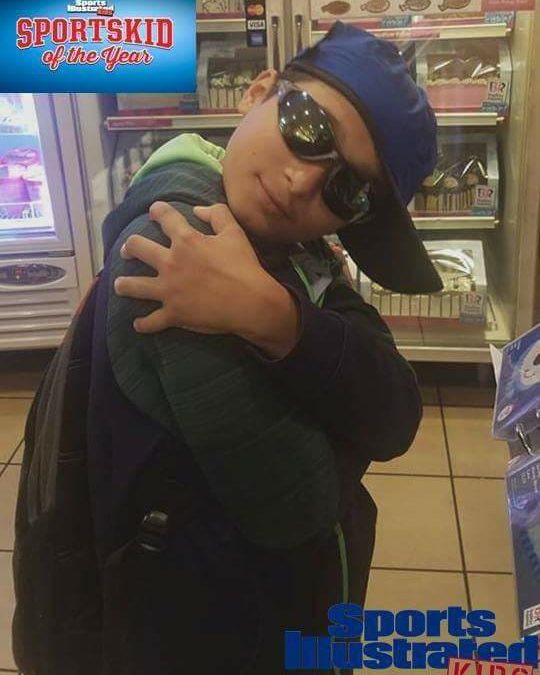
by Mike Melendez | Mar 18, 2018 | PFA Youth PB Profile
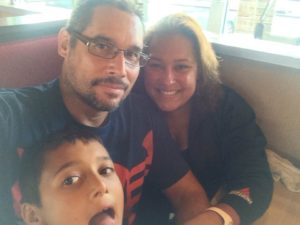
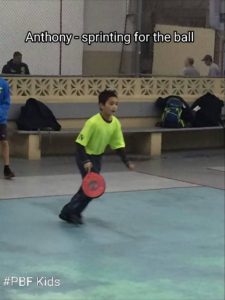
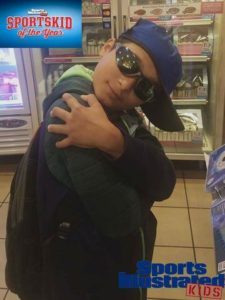
Anthony Rodriguez – Youth Paddleball Profile No1 by Mike Melendez
He is a special kid, an “A” student, accepted to Amber National Elementary Honor Society, which is his proudest moment so far in his young life. He has his parents’ DNA for one-wall sports, hence he is one of the top students in the PFA Paddleball Clinic and is one of the most promising youth paddleball talents in the game today. At Zerega, Orchard Beach, Red Hook and other one-wall courts across the tri-state area, you can often find him practicing by himself, with other kids or with adults. Like his favorite superhero, “The Panther,” the kid is everywhere! It seems like his dream of being able to perform “teleportation” is already a reality!
Li’l Anthony Rodriguez, A-Rod, as he likes to be called, is the pride and joy of two outstanding paddleball and racquetball players: Anthony and Kim Rodriguez. He is 11 years old and is a heck of a paddleball player. To me there is no doubt that if he keeps playing, he will win many paddleball championships as part of the next paddleball generation. However, because he is such a good athlete, paddleball does not have his full attention. You see, at the moment, basketball is his favorite sport, but paddleball is right behind, a close second. I asked him what piqued his interest in playing paddleball. To my surprise, it was not his parents’ love of the game. “I saw a few kids playing at the PFA’s paddleball clinic at Zerega and wanted to join them.” Li’l Anthony likes paddleball because it “keeps me active, fit and improves my hand-eye coordination.” His favorite shot is the low serve, which he is proud of because it required lots of practice to develop. Even though his number one sport is basketball, his favorite thing to do is “play paddleball outdoors!”
I love to coach him because he is passionate about being the best and he strives for perfection by practicing every chance he gets – two qualities needed in life to be the BEST we can be. Li’l Anthony is by far the hardest working kid in the PFA Youth Program. It’s remarkable that at this young age, he is able to balance his sports activities with his schoolwork, while maintaining his “A” student status. His favorite day of the week is Wednesday, “because I’m able to attend school, play basketball and paddleball.” Like his favorite color, neon green, “Wednesday is bright and fun! It is the perfect day of the week!” What is the meaning of good sportsmanship on the court? “Have a good attitude and shake hands at the end of game. If a bad call goes against you, take it over and move on.” He loves the PFA clinic because it teaches him how to play the game better and enables him to meet new friends that can last a lifetime.
On the personal side, A-Rod’s favorite subject in school is Math. His dream is to become a professional basketball player. And who is his sport hero? Of course it’s A-Rod! But not Alex Rodriguez, formerly of the Yankees, it is his father Anthony Rodriguez, the paddleball player! His favorite movie, of course, is “Black Panther.” Jack Sullivan, who writes great kids stories about Zombie fighters, is his favorite author. With everything this special kid has going for him, it’s surprising to hear him say that he is shy and he feels a bit uncomfortable playing in front of big crowds, but the PFA clinic is teaching him how to relax and feel more at ease.
The Panther is coming to courts near you. A-Rod Got Next!
by Mike Melendez | Mar 7, 2018 | Weekly Player Profile
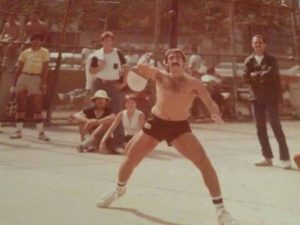
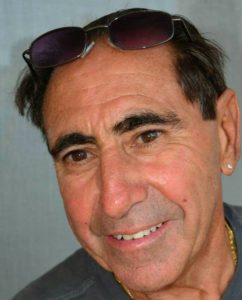
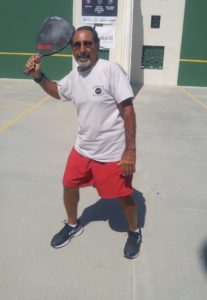
Caesar Polichetti Paddleball Profile by Dave Siegel
Remember the children’s storybook, “The Little Engine That Could?” In baseball, it’s José Altuve, the diminutive American League MVP who led the Astros to the World Championship. Remember Pete Rose, the ball player (not the gambler)? He was hard-nosed, hustling, fighting for every edge, and always playing all-out. Put them both together and you have Caesar Polichetti who, despite being very far from a tall man, has a very big heart and all his life said, “I think I can! I think I can!” just like the little locomotive. And, like Pete Rose, he played every point of every game fiercely, striving for the ultimate goal: winning. Caesar’s athletic ability and dedication, combined with his persona, enabled him to become one of the best paddleball players from the late 70s and 80s, the golden era of paddleball.
The story of Caesar Polichetti goes back to Brooklyn in the mid-1970s when Caesar, who was then a handball player, saw paddleball being played at Seth Low Playground. It looked like a game he wanted to try and, along with his friend Rocco, he bought a $3 paddle and started practicing. A month later, thinking they were ready for competition, they went to the park under the Verrazano Bridge where they had heard there were good games. Guess what? Caesar got crushed. But this man with the big heart would not be fazed. (I think I can!) He went back to Seth Low, determined to learn the game and become a good player. He bought a Black Beauty, found a mentor, an experienced player named Howie, and practiced and practiced, his game quickly developing. He and Howie returned to the Verrazano a few months later and as they entered the courts, they gazed at the faces of the players. They were all silently saying “Oh no, this guy’s back!” But it was a different story this time. No, they didn’t beat everyone, but they were competitive, winning and losing. He was now welcome and the Verrazano courts became his home park.
A few years later, Caesar, now one of the finest players around, heard that the best players in Brooklyn were at Bay 8thStreet. So he and most of the guys packed up and moved to Bay 8th. Some of the better known competitors that moved from the Verrazano to Bay 8th were Patty Ranieri, Andrew Grosso, Sal Gargiulo, Paul Coscione, Alex (Batman) Cordani, Frank Calabria, and Anthony Russo. There, they met up with Donnie Ciaffone, Bob Kessler, George Helmerich, Jerry Resnick and Eddie Pino. Caesar teamed up with George and they played in many tournaments together and became one of the top (and toughest) teams in the game.
Reflecting now, Caesar says that his stature was an asset to him in paddleball, propelling him to go all out on every point of every game against the top players. Never giving in to any physical advantage they had, nor complaining about rough play, he is proud to say he was “not a crybaby.” “Get inside, you bump me, I bump you.” He was never in awe of any of the greats he competed against, even playing singles in tournaments against the likes of Bobby Schwarz and Mike Melendez. He was an offensive player, always looking to get front position. His favorite shot? the Killer, of course.
Another factor in Caesar becoming the man he turned out to be is that he grew up in an era which was far different from today. There were no video games! He and his friends were always playing sports or city games, like stickball, stoopball, punchball, boxball and eventually turning to handball. It was these sports activities that kept him on the straight and narrow and probably a major reason he became who he is.
Later in his career, now an older player, Caesar teamed up with Alex (Batman) and played in Masters competitions. Back then, during paddleball’s heyday, the Masters drew large numbers of top players, many of whom were still playing open competition. Caesar and Batman won the 1988 and ’89 Budweiser Masters, beating Marvin Haberman in the finals both years.
Is there a soft side to Caesar Polichetti? Yes, speaking first hand, he is a gentleman (off the court!). Caesar related to me that when he watches a game, though he may want a particular person to win, he never roots outwardly, showing respect for all the players. Plus, he was not only one of the best paddleball players from the golden era, but he was a mentor. Go back in the PFA archives and check out what Donnie Ciaffone had to say about Caesar: “While coming up in the sport at Bay 8th, a great legend named Caesar Polichetti took me under his wing and taught me discipline, technique and how to use my left hand.”
Caesar’s success in sports goes beyond paddleball. Overlapping his prime years, he was a serious and successful marathon runner. He competed in five NYC marathons, finishing them all, achieving a best time of 3:33. He put in many hours and miles training for these events. In his earlier days, he played table tennis competitively, winning a city-wide tournament in which there were over five thousand entries! After he wound down in paddleball, Caesar went back to handball where he was a good competitive player in this very demanding sport. It’s obvious that when Caesar decided to take up a sport, “I think I can!” would kick in.
Caesar goes down as one of the best and well-known players in paddleball history. He played against the great players from his era. He highlights these legends (but notes there were many others): Steve Rothfeld, Barry Scheiber, Bobby Schwarz, Andy Krosnick, Howie Solomon, Anthony Fiorino, Robert Chielli, Richie Miller, Glen Winokur, Andr’e (Hop) Hopkins, Craig Ruiz, Ralph Capogrosso, Bobby Fiorentino, Whitey Faber, Ray Gaston, Mike Melendez, Donnie Ciaffone and Anita Maldonado.
Present day, Caesar lives in Hollywood, Florida and continues to play in Garfield Park a couple of days a week. His regular partner is Phil Leone. Remarkably, he has had two knee replacements and three rotator cuff shoulder surgeries. Now playing the big ball game, he considers himself a “decent right-side defensive player.” And do you believe this? “No more arguments!” Also he still plays table tennis and even plays pickleball now and then.
Caesar loves the direction that paddleball has taken in the last few years with the PFA, led by the “sensational” work of Mike Melendez and his team and its emphasis on developing the children. “The kids are very lucky to have the role models that the Paddleball Family Alliance provides for them. Thank you Mike!”
Remember how “The Little Engine That Could” ended? “I thought I could. I thought I could.” Yes, that’s Caesar Polichetti and he sure could! (And still can!) If you have a young child or grandchild, get “The Little Engine That Could,” by Watty Piper. Read it to them, they’ll love it! Think of Caesar.
by Mike Melendez | Feb 24, 2018 | Blogs
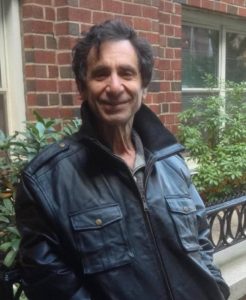
The Poker Game By Michael Leiman
The competition at the five paddleball courts off Carmine Street in Manhattan was ferocious. No one wanted to lose and all of us fought like mad, yelled like mad, disputed calls like mad, to avoid it. But, in the end, one team got to 15 before the other. The winner stayed on. The loser trudged to the sidelines to await their next chance.
And wait. And sometimes wait some more. The courts were not just ferocious. They were crowded. Sometimes the waits extended to ten games. And waiting was not something we were good at. We were competitive athletes and wanted to do something. Well, there was a bocce area behind the courts if you wanted to roll a ball. And there was a small softball field where you could kick a soccer ball. Or you could go to the store and get something to drink.
Billy Abolafia did none of those things. Billy was one of the characters at Carmine Street. Tall, powerfully built, with long, curly hair, he was a charismatic figure that drew people to him. He was also a gambler. He brought his cards and set up a poker game on the cement tables and wooden benches just a few feet beyond the courts. Losing players came to join in. I came to join in.
The game was quarter/half. Open for a quarter with three raises allowed. If someone showed a pair the betting began at 50 cents. Not a small amount of money in the late 1980s, but limited enough that no one could get badly hurt. Just a few dollars would change hands. Then Billy suggested that the very last bet go to a dollar. Hmmm, a dollar bet followed by three raises, that would make $4 on just one card. Hey, the game was getting interesting! Too interesting, that is, too remain at an outdoor table with strangers now watching with players that came and went whenever their turn on the courts came up, with dollar bills flying around and being blown by the wind. We took the game indoors. To the apartment on the far West Side that Billy shared with his girlfriend. Now the poker game wasn’t interrupted by anything. We’d play for hours; sometimes all night.
Thing had become serious. We were, after all, serious competitors. The quarters and half dollars disappeared. Now the game was $1/$2. At Billy’s suggestion, the final bet became $5, then $10. Raise that three times and…now we were talking REAL money!
We mostly played a silly game, however, Baseball. Baseball was generally a 7 card stud game…2 closed cards followed by 4 open cards with a bet on each one and concluding with one final card. Threes and nines were wild. An open four got you another card. Crazy! In my first night of playing I couldn’t figure out what a likely winning hand was. Until I did!
No way you could win with less than four jacks. You couldn’t feel confident with less than four aces. I built my strategy around that insight. I’d drop out early if it seemed improbable that my hand would be that good. I’d save my big money bets for the times my cards were likely winners. Billy was still the best player at the table but now I had a clear insight into the game.
Two things kept most everyone else from developing the same clarity. All our players came from Carmine Street, but not all of them were paddleball players. Two of them were the court’s drug dealers. Now call me naive, but I didn’t know we had drug dealers. But, apparently, we did. And they were nice guys. They brought their “product” to the table and it was free for anyone who wanted it. As was the beer. I partook of nothing. That gave me an awfully big advantage.
And then Anita Maldonado joined the game! I love Anita. She is an exciting, fun person who was also the reigning woman’s singles and doubles champion. She was among the fiercest competitors I’ve ever met. No lead over her was ever safe. She didn’t (and likely still doesn’t) know the meaning of give up. Her oft stated motto: “You’ve got to be in it to win it.” A GREAT attitude in sports. NOT a good one in poker where “you’ve got to know when to hold em, know when to fold em.” Leave a likely losing hand early and you drop a few bucks. Fight an unwinnable battle to the end and you can lose a lot! Anita, the drug dealers and a few others often fought to the bitter end.
My philosophy was different. Play sober, play conservative and go in big when I recognized my cards were likely the winner. The drug dealers brought lots of cash and they didn’t seem to mind when they lost it. They just seemed puzzled when their hands were nowhere close to what the winners held. To cheer them up I’d smile and remind them: “You’ve got to be in it to win it.” No matter their probability of winning, they remained in it!
In one memorable hand I was fighting it out with Anita. I held a couple of wild cards and bet strong. Anita, who didn’t seem to have much, stayed with me and then, towards the end, raised aggressively. My reading of the hand was that I was almost the sure winner but Anita’s strong bets scared me. I backed off, merely calling her at the end.
“What do you have?” I asked nervously.
“A pair of aces.”
“Aces?” I responded, incredulously. Maybe I’d heard wrong. “You have a pair of aces?”
“Yeah, aces. What do you have?”
“Four kings,” I replied, pulling in all the chips. Wow!
My gosh, how could she have stayed in with aces? A game with a million wild cards and you’re in with aces? And then of course I remembered: “You’ve got to be in it to win it.”
And that’s how, though I did not win all the time at Carmine I certainly did at Billy’s!
The losing, however, was not good for the drug dealers. One of them, Larry, called and asked me for a $1000 loan to help him buy “product.” He’d pay me back in a week along with an extra hundred. I declined. I’d turned my back on the opportunity to get into the drug racket!
The game went on without the out of funds drug dealers, but it had grown crazy. Somehow the allowable bet on the last card had morphed to $100. Three raises could bring that to $400. None of us could afford that kind of money. One night I won close to $1000 but went home with $125 and a pocketful of IOUs.
A non-Carmine Street guy joined the game. His name was Mike. His nickname was Psycho. Psycho Mike. I soon discovered why. When he learned that I was a psychotherapist he accused me of cheating by reading people’s minds. I learned from Billy that Psycho Mike generally carried a gun. I did the math: Big money, cocaine, a weapon and paranoia added to a combination I didn’t want to deal with.
The Poker Game was over for me!






















Recent Comments